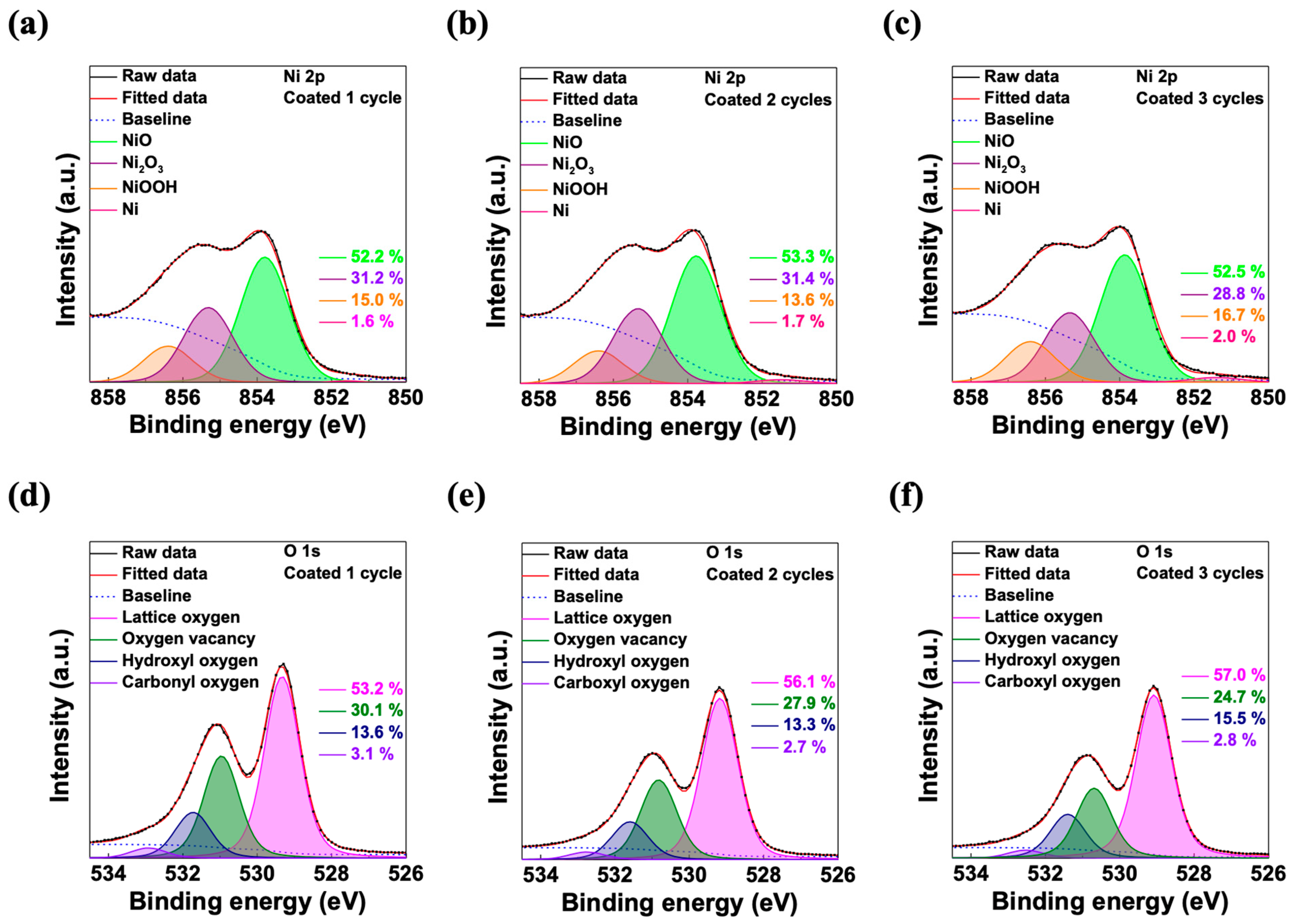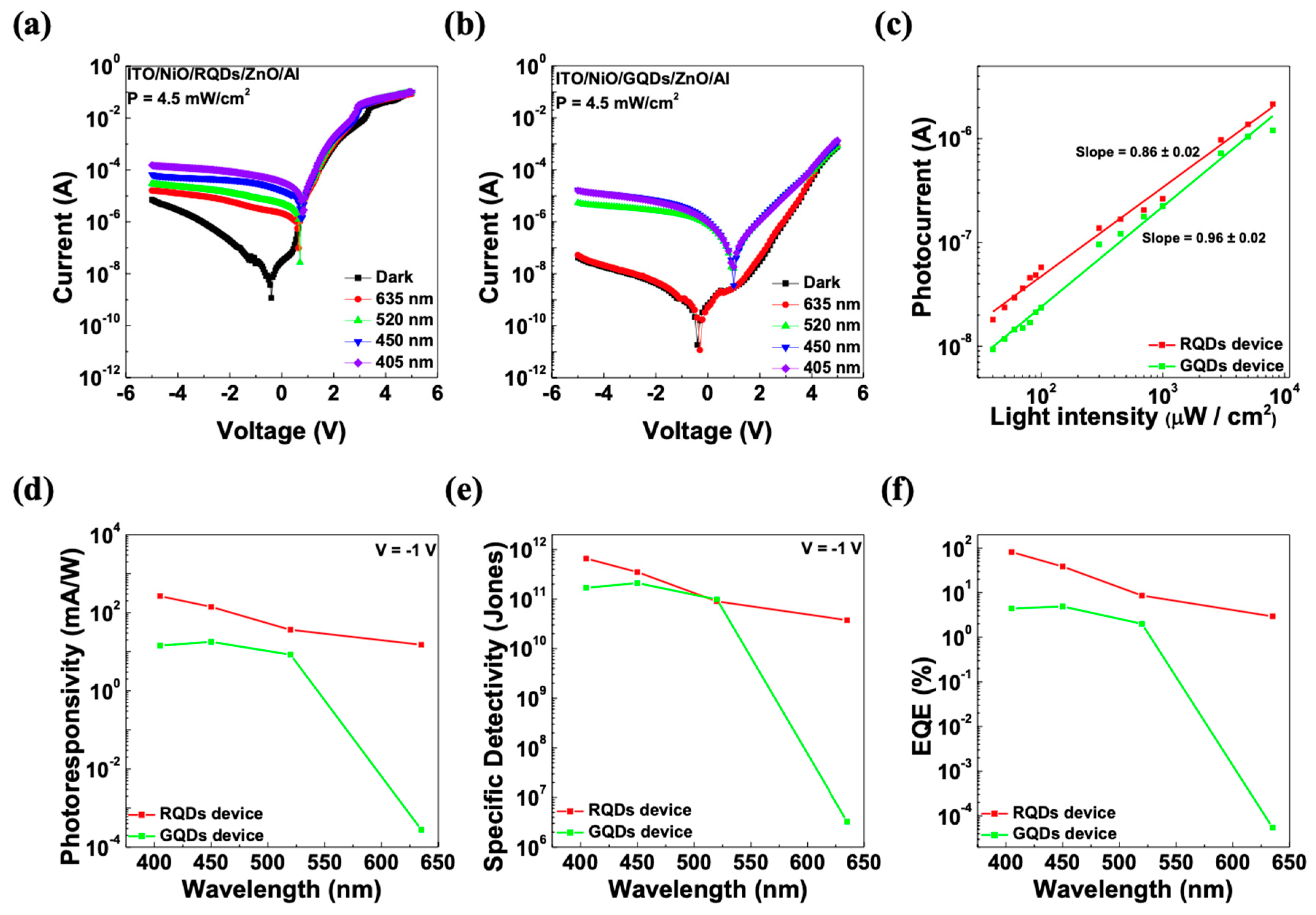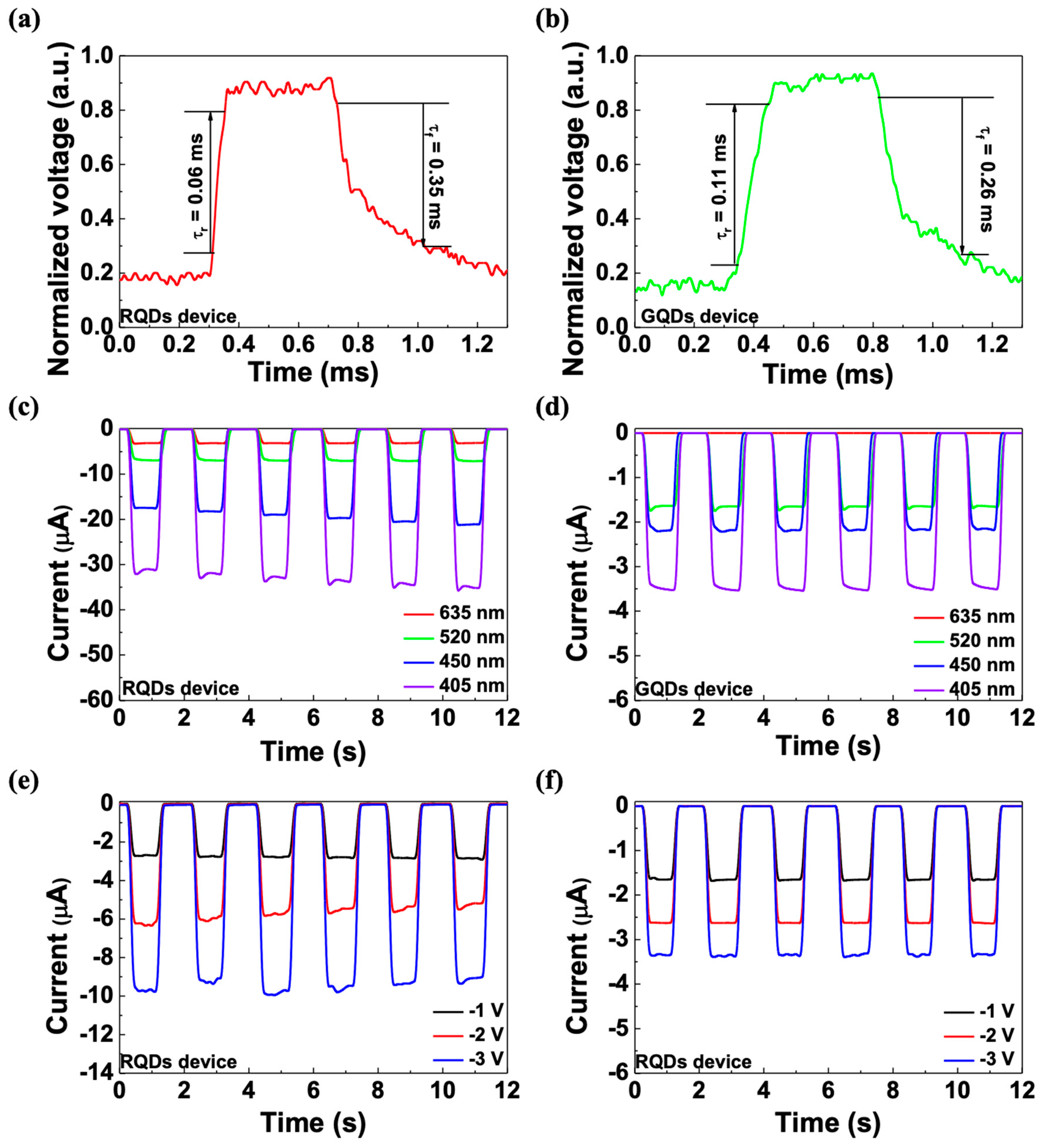Enhancement of the Visible Light Photodetection of Inorganic Photodiodes via Additional Quantum Dots Layers
Abstract
:1. Introduction
2. Experimental Section
2.1. Synthesis of the NiO Solution
2.2. Photodiode Fabrication
2.3. Characterization
3. Results and Discussion
4. Conclusions
Supplementary Materials
Author Contributions
Funding
Data Availability Statement
Conflicts of Interest
References
- Yadav, P.K.; Ajitha, B.; Reddy, Y.A.K.; Sreedhar, A. Recent advances in development of nanostructured photodetectors from ultraviolet to infrared region: A review. Chemosphere 2021, 279, 130473. [Google Scholar] [CrossRef]
- Silva, J.P.; Vieira, E.M.; Gwozdz, K.; Silva, N.E.; Kaim, A.; Istrate, M.C.; Ghica, C.; Correia, J.H.; Pereira, M.; Marques, L. High-performance and self-powered visible light photodetector using multiple coupled synergetic effects. Mater. Horiz. 2024, 11, 803–812. [Google Scholar] [CrossRef]
- Song, H.-J.; Seo, M.-H.; Choi, K.-W.; Jo, M.-S.; Yoo, J.-Y.; Yoon, J.-B. High-performance copper oxide visible-light photodetector via grain-structure model. Sci. Rep. 2019, 9, 7334. [Google Scholar] [CrossRef]
- Chwieduk, D.A. Towards modern options of energy conservation in buildings. Renew. Energy 2017, 101, 1194–1202. [Google Scholar] [CrossRef]
- Li, Y.; Li, T.; Patel, R.A.; Yang, X.-D.; Zhou, X. Self-powered gesture recognition with ambient light. In Proceedings of the 31st Annual ACM Symposium on User Interface Software and Technology, Berlin, Germany, 14–17 October 2018; pp. 595–608. [Google Scholar]
- Amft, O.; Wahl, F.; Ishimaru, S.; Kunze, K. Making regular eyeglasses smart. IEEE Pervasive Comput. 2015, 14, 32–43. [Google Scholar] [CrossRef]
- Hai, Z.; Karbalaei Akbari, M.; Wei, Z.; Zuallaert, J.; De Neve, W.; Xue, C.; Xu, H.; Verpoort, F.; Zhuiykov, S. Electrochromic photodetectors: Toward smarter glasses and nano reflective displays via an electrolytic mechanism. ACS Appl. Mater. Interfaces 2019, 11, 27997–28004. [Google Scholar] [CrossRef]
- Kim, J.; Salvatore, G.A.; Araki, H.; Chiarelli, A.M.; Xie, Z.; Banks, A.; Sheng, X.; Liu, Y.; Lee, J.W.; Jang, K.-I. Battery-free, stretchable optoelectronic systems for wireless optical characterization of the skin. Sci. Adv. 2016, 2, e1600418. [Google Scholar] [CrossRef]
- Lochner, C.M.; Khan, Y.; Pierre, A.; Arias, A.C. All-organic optoelectronic sensor for pulse oximetry. Nat. Commun. 2014, 5, 5745. [Google Scholar] [CrossRef]
- Choi, C.; Colón-Berríos, A.R.; Hamachi, L.S.; Owen, J.S.; Schwartz, T.H.; Ma, H.; Kymissis, I. Localizing seizure activity in the brain using implantable micro-LEDs with quantum dot downconversion. Adv. Mater. Technol. 2018, 3, 1700366. [Google Scholar] [CrossRef]
- Liu, S.; Zhang, X.-d.; Gu, X.; Ming, D. Photodetectors based on two dimensional materials for biomedical application. Biosens. Bioelectron. 2019, 143, 111617. [Google Scholar] [CrossRef]
- Li, M.; Xu, J.; Zhu, K.; Shi, S.; Zhang, Q.; Bu, Y.; Chen, J.; Xu, J.; Zheng, Q.; Su, Y. The fabrication of a self-powered CuInS2/TiO2 heterojunction photodetector and its application in visible light communication with ultraviolet light encryption. J. Mater. Chem. C 2021, 9, 14613–14622. [Google Scholar] [CrossRef]
- Wu, Y.; Li, X.; Wei, Y.; Gu, Y.; Zeng, H. Perovskite photodetectors with both visible-infrared dual-mode response and super-narrowband characteristics towards photo-communication encryption application. Nanoscale 2018, 10, 359–365. [Google Scholar] [CrossRef]
- Bu, Y.; Xu, J.; Shi, S.; Chen, J.; Li, M.; Zhang, Q.; Yang, P.; Xu, J.; Zhang, X.; Kong, L. Control of the Cu2O crystal orientation and the application of a ZnO/Cu2O self-powered photodetector in visible-light-encrypted communication. J. Mater. Chem. C 2021, 9, 9203–9211. [Google Scholar] [CrossRef]
- Arredondo, B.; Romero, B.; Pena, J.M.S.; Fernández-Pacheco, A.; Alonso, E.; Vergaz, R.; De Dios, C. Visible light communication system using an organic bulk heterojunction photodetector. Sensors 2013, 13, 12266–12276. [Google Scholar] [CrossRef]
- Guo, K.; Tang, Z.; Chou, X.; Pan, S.; Wan, C.; Xue, T.; Ding, L.; Wang, X.; Huang, J.; Zhang, F. Printable organic light-emitting diodes for next-generation visible light communications: A review. Adv. Photonics Nexus 2023, 2, 044001. [Google Scholar] [CrossRef]
- Liu, M.; Yazdani, N.; Yarema, M.; Jansen, M.; Wood, V.; Sargent, E.H. Colloidal quantum dot electronics. Nat. Electron. 2021, 4, 548–558. [Google Scholar] [CrossRef]
- Nguyen, T.M.H.; Shin, S.G.; Choi, H.W.; Bark, C.W. Recent advances in self-powered and flexible UVC photodetectors. Exploration 2022, 2, 20210078. [Google Scholar] [CrossRef]
- Sze, S.; Ng, K.K. Physics of Semiconductor Devices; John Wiley & Sons: New York, NY, USA, 1981; Volume 68. [Google Scholar]
- Roose, B.; Wang, Q.; Abate, A. The role of charge selective contacts in perovskite solar cell stability. Adv. Energy Mater. 2019, 9, 1803140. [Google Scholar] [CrossRef]
- You, J.; Meng, L.; Song, T.-B.; Guo, T.-F.; Yang, Y.; Chang, W.-H.; Hong, Z.; Chen, H.; Zhou, H.; Chen, Q. Improved air stability of perovskite solar cells via solution-processed metal oxide transport layers. Nat. Nanotechnol. 2016, 11, 75–81. [Google Scholar] [CrossRef]
- Singh, M.; Ng, A.; Ren, Z.; Hu, H.; Lin, H.-C.; Chu, C.-W.; Li, G. Facile synthesis of composite tin oxide nanostructures for high-performance planar perovskite solar cells. Nano Energy 2019, 60, 275–284. [Google Scholar] [CrossRef]
- Patel, V.D.; Gupta, D. Solution-processed metal-oxide based hole transport layers for organic and perovskite solar cell: A review. Mater. Today Commun. 2022, 31, 103664. [Google Scholar] [CrossRef]
- Tao, K.; Xiong, C.; Lin, J.; Ma, D.; Lin, S.; Wang, B.; Li, H. Self-Powered Photodetector Based on Perovskite/NiOx Heterostructure for Sensitive Visible Light and X-Ray Detection. Adv. Electron. Mater. 2023, 9, 2201222. [Google Scholar] [CrossRef]
- Zheng, Z.; Zhuge, F.; Wang, Y.; Zhang, J.; Gan, L.; Zhou, X.; Li, H.; Zhai, T. Decorating perovskite quantum dots in TiO2 nanotubes array for broadband response photodetector. Adv. Funct. Mater. 2017, 27, 1703115. [Google Scholar] [CrossRef]
- Gong, W.; Wang, P.; Li, J.; Li, J.; Zhang, Y. Elucidating the Gain Mechanism in PbS Colloidal Quantum Dot Visible–Near-Infrared Photodiodes. J. Phys. Chem. Lett. 2022, 13, 8327–8335. [Google Scholar] [CrossRef]
- Zhao, P.; Qin, T.; Mu, G.; Zhang, S.; Luo, Y.; Chen, M.; Tang, X. Band-engineered dual-band visible and short-wave infrared photodetector with metal chalcogenide colloidal quantum dots. J. Mater. Chem. C 2023, 11, 2842–2850. [Google Scholar] [CrossRef]
- Chun, J.Y.; Kim, B.G.; Kim, J.Y.; Jang, W.; Wang, D.H. Passivation engineering via silica-encapsulated quantum dots for highly sensitive photodetection. Carbon Energy 2023, 5, e350. [Google Scholar] [CrossRef]
- Lan, Z.; Lei, Y.; Chan, W.K.E.; Chen, S.; Luo, D.; Zhu, F. Near-infrared and visible light dual-mode organic photodetectors. Sci. Adv. 2020, 6, eaaw8065. [Google Scholar] [CrossRef]
- Zhang, C.; Cao, Y.; Song, Y.; Yu, G.; Lan, L.; Zhou, C.; Lin, Z.; Wang, L.; Li, N.; Huang, F. Organic photodiodes with thermally reliable dark current and excellent detectivity enabled by low donor concentration. ACS Appl. Mater. Interfaces 2023, 15, 7175–7183. [Google Scholar] [CrossRef]
- García de Arquer, F.P.; Armin, A.; Meredith, P.; Sargent, E.H. Solution-processed semiconductors for next-generation photodetectors. Nat. Rev. Mater. 2017, 2, 16100. [Google Scholar] [CrossRef]
- Klimov, V.I. Multicarrier Interactions in Semiconductor Nanocrystals in Relation to the Phenomena of Auger Recombination and Carrier Multiplication. Annu. Rev. Condens. Matter Phys. 2014, 5, 285–316. [Google Scholar] [CrossRef]
- Reddy, B.K.S.; Panda, S.; Ramasamy, E.; Veerappan, G.; Borse, P.H.; Badhulika, S. Exploring the impact of electron transport layer thickness and morphology on perovskite infiltration and photoresponse in HTM-free self-powered photodetector. Sol. Energy 2023, 265, 112106. [Google Scholar] [CrossRef]
- Simone, G.; Dyson, M.J.; Meskers, S.C.; Janssen, R.A.; Gelinck, G.H. Organic photodetectors and their application in large area and flexible image sensors: The role of dark current. Adv. Funct. Mater. 2020, 30, 1904205. [Google Scholar] [CrossRef]
- Cao, J.; Yu, H.; Zhou, S.; Qin, M.; Lau, T.-K.; Lu, X.; Zhao, N.; Wong, C.-P. Low-temperature solution-processed NiOx films for air-stable perovskite solar cells. J. Mater. Chem. A 2017, 5, 11071–11077. [Google Scholar] [CrossRef]
- Zhang, Z.; Liu, B.; Quinteros, F.; Zhai, X.; Wang, Q.; Han, W.; Xie, E.; Reyes-Lillo, S.E.; Cooper, J.K. Understanding the Role of Oxygen and Hydrogen Defects in Modulating the Optoelectronic Properties of P-Type Metal Oxide Semiconductors. Chem. Mater. 2021, 33, 7829–7838. [Google Scholar] [CrossRef]
- Zhou, N.; Zhao, H.; Li, X.; Li, P.; You, Y.; Cai, M.; Xia, L.; Zhi, H.; Channa, A.I.; Wang, Z.M. Activating Earth-Abundant Element-Based Colloidal Copper Chalcogenide Quantum Dots for Photodetector and Optoelectronic Synapse Applications. ACS Mater. Lett. 2023, 5, 1209–1218. [Google Scholar] [CrossRef]
- Kublitski, J.; Hofacker, A.; Boroujeni, B.K.; Benduhn, J.; Nikolis, V.C.; Kaiser, C.; Spoltore, D.; Kleemann, H.; Fischer, A.; Ellinger, F. Reverse dark current in organic photodetectors and the major role of traps as source of noise. Nat. Commun. 2021, 12, 551. [Google Scholar] [CrossRef]
- Kim, Y.; Kim, J.; Kim, H.M.; Jang, J. Quantum-Dots Photosensor with Wide Bandgap P-Type and N-Type Oxide Semiconductors for High Detectivity and Responsivity. Adv. Mater. Technol. 2020, 5, 1900857. [Google Scholar] [CrossRef]
- Yu, H.; Liu, S.; Baek, S.; Dong, C.; So, F. Solution-processed copper oxide interlayers for broadband PbS quantum-dot photodiodes. J. Mater. Chem. C 2016, 4, 11205–11211. [Google Scholar] [CrossRef]





| Procedure | Materials | Condition |
|---|---|---|
| Substrate cleaning | DI-water, acetone, IPA | Sonicating for 15 min per step |
| UV-ozone treatment | O3 | Approximately 20 min |
| NiO spin-coating and thermal annealing | NiO solution | A coating rate of 3000 rpm (30 s) → 5 min annealing at 120 °C → 1~3 coating cycles → 40 min annealing at 180 °C |
| QDs spin-coating and thermal annealing | CdSe/ZnS (RQDs or GQDs) | A coating rate of 2000 rpm (30 s) → 30 min annealing at 180 °C |
| ZnO spin-coating and thermal annealing | ZnO nanoparticles (N10) | A coating rate of 2000 rpm (30 s) → 30 min annealing at 180 °C |
| Electrode deposition via thermal evaporation | Al | At a rate of 3 Å/s |
| Device Structure | Wavelength | Iphoto/Idark | Photoresponsivity (mA/W) | Detectivity (Jones) | EQE (%) | Rise/Fall Time (ms) | Ref. |
|---|---|---|---|---|---|---|---|
| ITO/NiO/RQDs/ZnO/Al | 635 nm | 1.35 × 102 | 14.98 | 3.73 × 1010 | 2.92 | 0.06/0.35 | This work |
| ITO/NiO/GQDs/ZnO/Al | 520 nm | 1.67 × 103 | 8.34 | 9.84 × 1010 | 1.99 | 0.11/0.26 | This work |
| ITO/Cu2SnS3–Ga2O3/CdZnSeS—ZnS QD/LZO/Al | 628 nm | - | 42.9 | 1.66 × 1012 | 8.46 | 2.1/2.6 | [39] |
| ITO/Cu2SnS3–Ga2O3/CdZnSeS—ZnS QD/LZO/Al | 540 nm | - | 185.4 | 7.19 × 1012 | 42.57 | - | [39] |
| ITO/CuOx/Pbs QDs/ZnO/Al | 1010 nm | - | 4.6 × 1012 | 15 | 0.009/0.010 | [40] |
Disclaimer/Publisher’s Note: The statements, opinions and data contained in all publications are solely those of the individual author(s) and contributor(s) and not of MDPI and/or the editor(s). MDPI and/or the editor(s) disclaim responsibility for any injury to people or property resulting from any ideas, methods, instructions or products referred to in the content. |
© 2024 by the authors. Licensee MDPI, Basel, Switzerland. This article is an open access article distributed under the terms and conditions of the Creative Commons Attribution (CC BY) license (https://creativecommons.org/licenses/by/4.0/).
Share and Cite
Kang, S.J.; Jeong, J.H.; Ma, J.H.; Park, M.H.; Ha, H.J.; Yun, J.M.; Kim, Y.B.; Kang, S.J. Enhancement of the Visible Light Photodetection of Inorganic Photodiodes via Additional Quantum Dots Layers. Micromachines 2024, 15, 318. https://doi.org/10.3390/mi15030318
Kang SJ, Jeong JH, Ma JH, Park MH, Ha HJ, Yun JM, Kim YB, Kang SJ. Enhancement of the Visible Light Photodetection of Inorganic Photodiodes via Additional Quantum Dots Layers. Micromachines. 2024; 15(3):318. https://doi.org/10.3390/mi15030318
Chicago/Turabian StyleKang, Seong Jae, Jun Hyung Jeong, Jin Hyun Ma, Min Ho Park, Hyoun Ji Ha, Jung Min Yun, Yu Bin Kim, and Seong Jun Kang. 2024. "Enhancement of the Visible Light Photodetection of Inorganic Photodiodes via Additional Quantum Dots Layers" Micromachines 15, no. 3: 318. https://doi.org/10.3390/mi15030318






